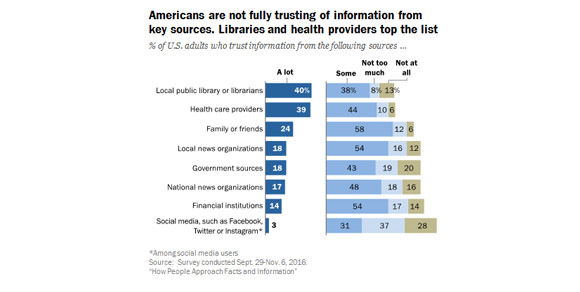Image credit: Pew Internet
A recent Pew survey shows that 40% of U.S. adults trust information from a local public library or librarians “a lot.” Thirty-eight percent of respondents said they trust libraries/librarians “some.” Totaling the percentage of respondents who trust a resource “a lot” or “some,” 83% trust health care providers, 82% trust family or friends, and 78% trust libraries/librarians. Libraries have the largest percentage of the strongest feelings of trust.
The survey divided participants into five groups based on their attitudes about information and learning, summarized below. “Interest” refers to how many different topics respondents expressed interest in. Groups with high interest expressed interest in more topics. “Trust” refers to how many sources of information respondents trust “a lot.” Higher trust means they trust more sources of information. “Training” means respondents said training on using online resources or digital technology would “contribute a lot” to their decision making.
| Group | Interest | Trust | Training | Percentage |
| Eager & Willing | Highest | High | High | 22% |
| Confident | High | Highest | Middle | 16% |
| Cautious & Curious | Middle | Middle | Highest | 13% |
| Doubtful | Low | Low | Low | 24% |
| Wary | Lowest | Lowest | Low | 25% |
Within each of these subgroups, trust of libraries/librarians varied. Out of the total number of participants who said that they trusted the libraries/librarians a lot, 73% were from the “eager & willing” group, 59% from the “confident” group, 29% from the “cautious & curious” group, 29% from the “doubtful” group, and 14% from the “wary” group. (Percentages do not total to 100% because respondents could say that they trust multiple sources “a lot.”)
The “eager & willing” group was the most likely to have interacted with their local library in the past 12 months through one of the following: visiting a library or bookmobile, using a public library website, or using a public library app. Out of all the groups, this one also expressed the strongest desire for both a public library closer to home and expanded library hours. The demographics of the “eager & willing” group show that the typical respondent in this group is: female, non-parent, white (though almost as likely to be black or Hispanic), 30-49 years old, with a household income of less than or equal to $30,000, has a high school education or less, and lives in an urban area.
This survey provides valuable information about perception of libraries, and points to some key questions about users and non-users. How can libraries continue to serve this specific population that is eager to use the library and further their skills? How can libraries also reach out to the other groups, who are less trusting of information sources in general?
You can access the full report here.
Note: This post is part of our series, “The LRS Number.” In this series, we highlight statistics that help tell the story of the 21st-century library.
